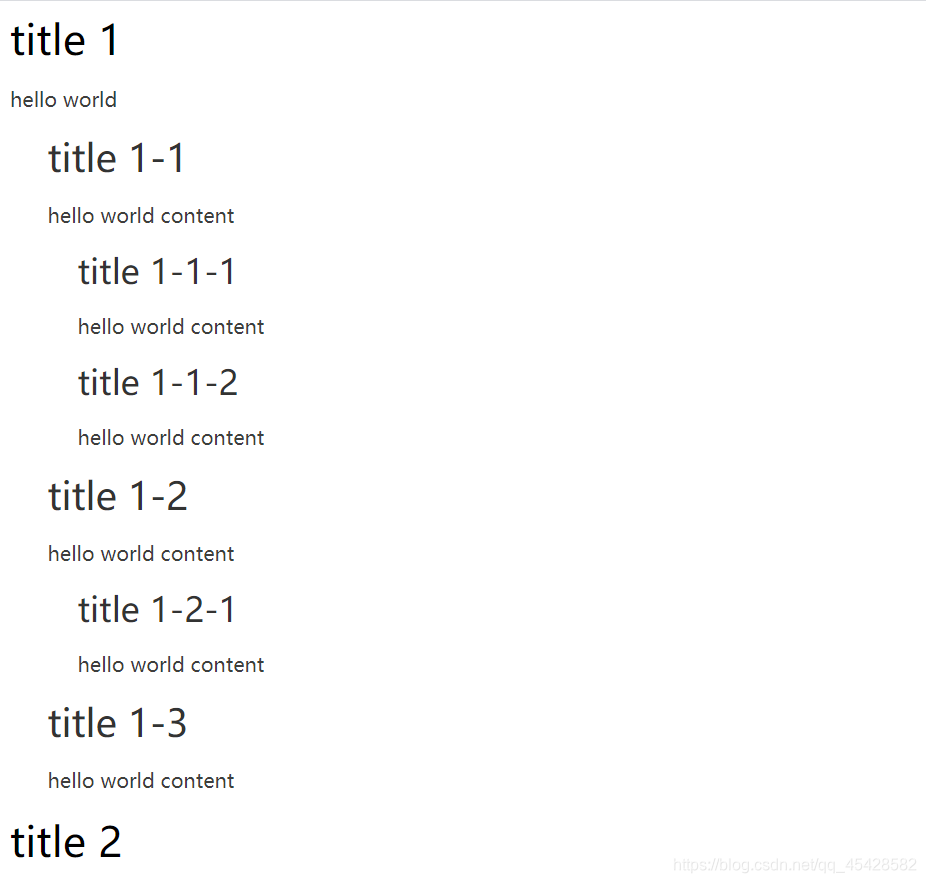被问道了,当时只是简单设计了一下,type等都没加上,重新实现了一下。
效果

// 数据结构
nodes: [
{
label: 'title 1',
content: 'hello world',
children: [
{
label: 'title 1-1',
content: 'hello world content',
children: [
{
label: 'title 1-1-1',
content: 'hello world content',
children: []
},
{
label: 'title 1-1-2',
content: 'hello world content',
children: []
}
]
},
{
label: 'title 1-2',
content: 'hello world content',
children: [
{
label: 'title 1-2-1',
content: 'hello world content',
children: []
},
]
},
{
label: 'title 1-3',
content: 'hello world content',
children: []
}
]
},
{
label: 'title 2',
content: 'hello world',
children: [
{
label: 'title 2-1',
content: 'hello world content',
children: []
},
{
label: 'title 2-2',
content: 'hello world content',
children: [
{
label: 'title 2-2-1',
content: 'hello world content',
children: []
},
{
label: 'title 2-2-2',
content: 'hello world content',
children: [
{
label: 'title 2-2-2-1',
content: 'hello world content',
children:[]
}
]
}
]
},
]
}, {
label: 'title 3',
content: 'hello world',
children: []
}
]
实现
重点就是组件递归。简单的props传参。在根据传参调整标题样式。
组件设计如下:
<script type="text/x-template" id='title'>
<div v-if="nodes.length > 0">
<div v-for="node in nodes" :style="strong">
{{node.label}}
<p :style="content">{{node.content}}</p>
<comp-title :nodes="node.children" :type="type + 1"></comp-title>
</div>
</div>
</script>
Vue.component('comp-title', {
template: '#title',
props: {
nodes: {
type: Array,
default: []
},
type: {
type: Number,
default: 1
}
},
data() {
return {}
},
computed: {
strong() {
let color = this.type * 1.5;
if (color >= 10) color = '#aaa';
else color = `#${color}${color}${color}`;
return {
'font-Size': (36 - 3 * this.type) + 'px',
'color': color,
'text-indent': (this.type - 1) + 'em'
}
},
content() {
return {
'font-Size': '16px',
'color': '#3e3e3e',
}
}
},
mounted() {
console.log(this.type);
}
});





 本文介绍了如何使用Vue实现树形标题的功能,重点在于组件的递归调用和通过props传递参数来定制标题样式。
本文介绍了如何使用Vue实现树形标题的功能,重点在于组件的递归调用和通过props传递参数来定制标题样式。
















 4629
4629

 被折叠的 条评论
为什么被折叠?
被折叠的 条评论
为什么被折叠?








